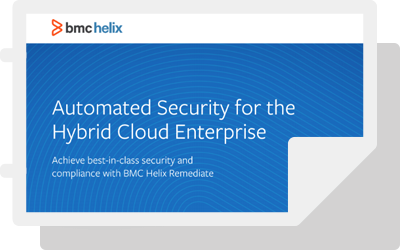Today’s enterprises are getting smarter about the cloud. In the early days of digital transformation, the hype around public cloud made it seem almost magical—a way for IT to increase agility, lower cost, and enable instant scalability with the wave of a wand. Over time, though, a more nuanced reality became apparent. On-demand resources can be a boon for developers, business units, and the organization as a whole, but their radical ease of provisioning can also lead to out-of-control costs, security gaps, management headaches, and the rueful discovery that not every workload is truly cloud-friendly. Having learned a few painful but important lessons, IT leaders are now making more thoughtful decisions about when and how to use the cloud—and discovering that the resulting value can still seem close to supernatural.
At the recent AWS re:Invent 2018 event in Las Vegas, Nevada, David Cramer, President of Digital Service Operations at BMC Software, sat down with John Walls and Justin Warren of the Cube to discuss the state of cloud thinking today. The following Q&A is adapted from their conversation.
What path are people taking to the cloud these days, and what are they doing there?
We see companies at every point on their cloud journey. While some are still just getting started, most have already begun moving apps to the cloud as well as building new cloud-native apps. But there’s an important difference from the early days. A few years ago, the word of the day was cloud-first, but you can spend a lot of money that way if you’re not careful. Now people are stepping back and thinking: What can cloud services and infrastructure really give us, and how can we optimize what we put in the cloud?
There’s a balance to strike here. DevOps culture is all about releasing more software into the market, faster—new features, products, and innovations. To do that at a competitive speed, you can’t have top-down command-and-control; you have to let teams be autonomous. At the same time, that creates opportunity for waste, mistakes, misconfigurations, and security issues. You have to keep your eyes open and have a real strategy for keeping things from getting out of control.
How is BMC helping customers decide what to move to cloud and what to keep on-premises?
During the heyday of lift-and-shift, a lot of people wanted to replatform and rearchitect everything in sight, but some of the apps they were looking at weren’t actually going to benefit from the cloud’s elasticity. You can deliver a virtual machine more cheaply in-house anyway, so what are you basing that decision on?
BMC has a rich history in the data center, and we’ve developed ways to assess and identify which high-value assets can really save you money in the cloud, and which are more suited to on-premises. You have to start with a foundation of app discovery, capacity and performance data, and insight into your configurations. To move something to the cloud, you first need to know what it looks like and how it runs in the data center.
Security is fundamental in the cloud. What’s BMC’s cloud security story?
Our cloud security strategy is based in large part on our own experiences. A few years ago, as our customers started wanting to consume services in different ways, we began building new apps in Amazon using Lambda. That meant we also had to learn how to secure them. We focused in particular on optimizing the security and configuration of the cloud infrastructure or platform layer. A lot of companies don’t understand Amazon’s shared responsibility model and expect someone else to take care of these problems. Amazon does provide a lot of security, but not for the stuff you put in your environment—your middleware, software, the services you connect, and so on. So we’re helping customers secure the configuration of those services.
There’s also an organizational factor. DevOps teams are often developer-heavy, and they’re not all that interested in compliance, code-scanning, or testing—they want to build cool stuff. We need to build protection around them and their processes so they can focus on what they’re best at.
What about the cost factor?
Cost is definitely a key area to focus on. A developer with access to the Amazon suite of services is like a kid in a candy store. They want gold-plated everything—the best environment and database, the most advanced services. It takes a mature, fully empowered cloud cost control practice to make sure you’re spending the right money in the right ways, and we’re helping a lot of customers develop that capability.
The scale of modern data volumes is truly mind-boggling. Has it grown beyond our ability to keep up?
Most people would agree that we’re well past human scale at this point. There are millions of containers spun up every day for Google Maps alone. You can’t take old approaches to something like that. We used to talk about pushbutton automation, but it was smart people figuring out what to automate, and only then pushing the button. Now we’re getting to a new level of trust, allowing the automation routines to take over and run on their own, whether driven by machine learning and AI algorithms or just by simple policies. That’s still a hard shift to make, though—it runs against instinct. Just as in DevOps, CIOs are concerned about guardrails and governance. They want to allow autonomy but also need to restrict the potential for mistakes and cost overruns.
Taking the broad view, this is an exciting and dynamic time to be in cloud, and in IT ops in general. Ops teams are moving into DevOps and cloud ops, and more and more you have everyone working together as a team—ops everywhere, dev everywhere. IT ops people have always been good at running things, and now IT ops teams are getting the dev and coding skills they need to both run and reinvent. The cloud is central to that vision, from providing the resources to enable DevOps, to transforming the way organizations provision, optimize, and manage their infrastructure as a whole. We’re thrilled to be at the heart of it all, and we’re inspired every day by what we see our customers accomplishing.







